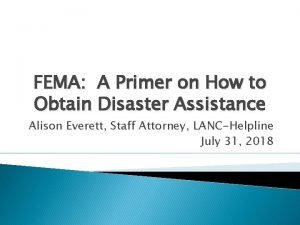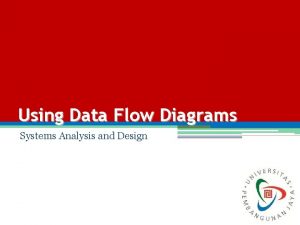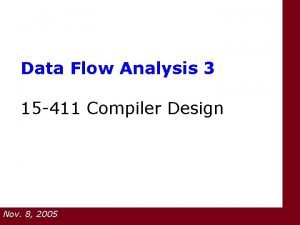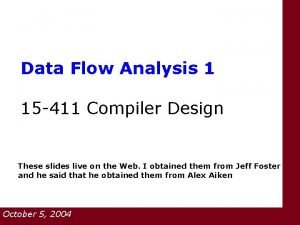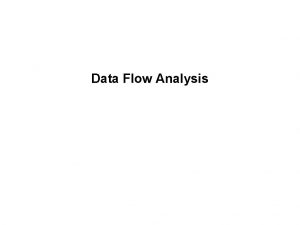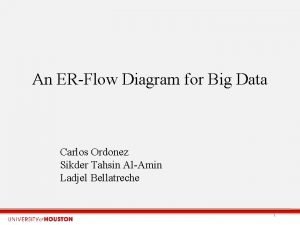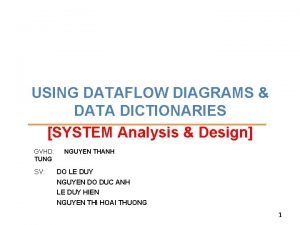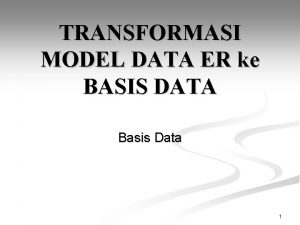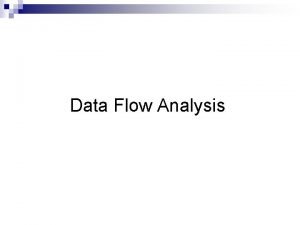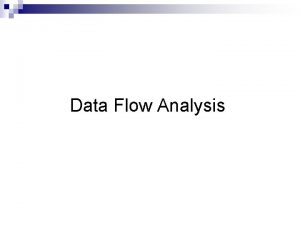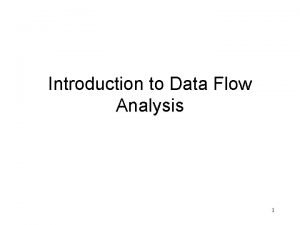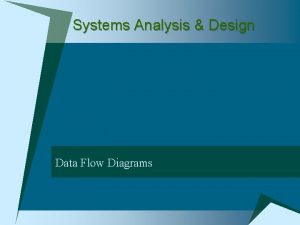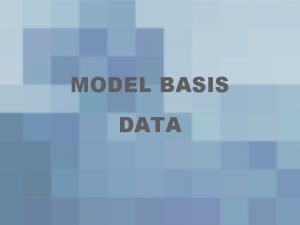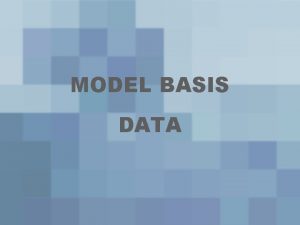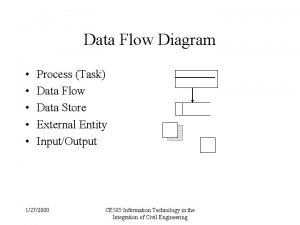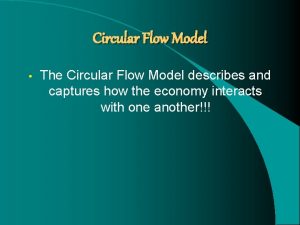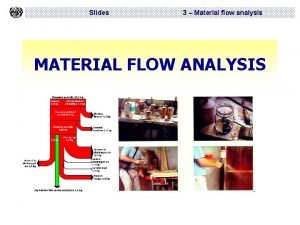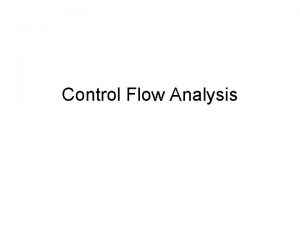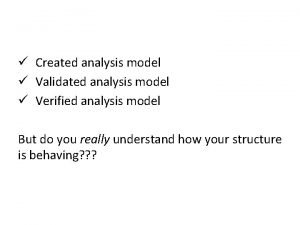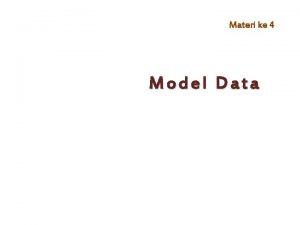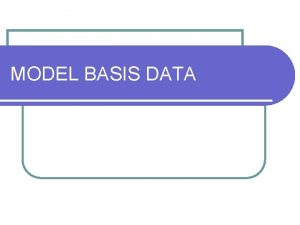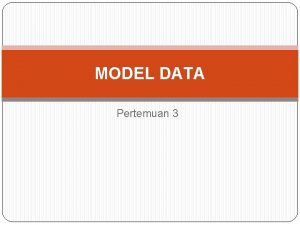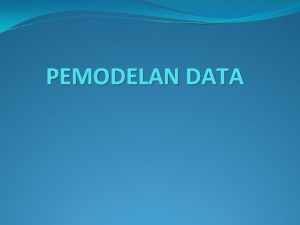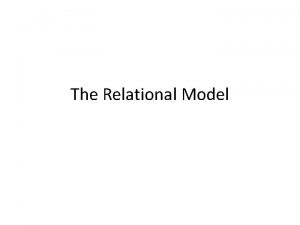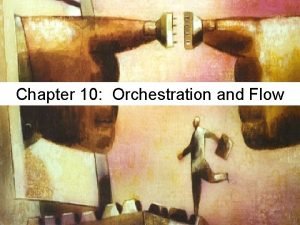Data Flow Analysis II 15 817 A Model











![General Iterative Data Flow Analysis Algorithm (Forward) // Boundary Condition Out[Entry] = V_Entry // General Iterative Data Flow Analysis Algorithm (Forward) // Boundary Condition Out[Entry] = V_Entry //](https://slidetodoc.com/presentation_image/c2aedd0ee544f1af4cd216285b277c70/image-12.jpg)

























- Slides: 37

Data Flow Analysis II 15 -817 A Model Checking and Abstract Interpretation Feb. 2, 2011

HAPPY GROUNDHOG DAY!

Agenda • Recalling last lecture • Analysis: Very Busy Expressions • {forward, backward}x{may, must} typology • Analysis: Live Variables • Analysis: Available Expressions • Where do we go from here?

Agenda • Recalling last lecture • Analysis: Very Busy Expressions • {forward, backward}x{may, must} typology • Analysis: Live Variables • Analysis: Available Expressions • Where do we go from here?

Recall: Last Lecture • Recall: Feynman-공 Method for data flow analysis • Recall: Our programming language • Recall: Control Flow Graphs (CFGs) • Recall: Reaching Definitions • Recall: Reaching Definition Analysis

Recall: Last Lecture • Recall: Semilattice, Complete Lattice • Recall: Monotone Functions, ACC, and their significance • Recall: General Algorithm

Today: Cosmetic Changes Let s be a statement: • succ(s) = {immediate successor statements of s} • Pred(s) = {immediate predecessor statements of s} • In(s) = flow at program point just before executing s • Out(s) = flow at program point just after executing s • In(s) = I s’ 2 pred(s) Out(s’) • Out(s) = Gen(s) [ (In(s) – Kill(s)) (Must) (Forward) • Note these are also called transfer functions Gen(s) = set of facts true after s that weren’t true before s Kill(s) = set of facts no longer true after s

Agenda • Recalling last lecture • Analysis: Very Busy Expressions • {forward, backward}x{may, must} typology • Analysis: Live Variables • Analysis: Available Expressions • Where do we go from here?

Very Busy Expressions: Definitions An expression is very busy at the exit from a label if, no matter what path is taken from the label, the expression must always be used before any of the variables occurring in it are redefined. For each program point, which expressions must be very busy at the exit from the point?

Very Busy Expressions: CFG 1: a > b true false 2: x : = b - a 4: y : = b - a 3: y : = a - b 5: x : = a - b

Agenda • Recalling last lecture • Analysis: Very Busy Expressions • {forward, backward}x{may, must} typology • Analysis: Live Variables • Analysis: Available Expressions • Where do we go from here?
![General Iterative Data Flow Analysis Algorithm Forward Boundary Condition OutEntry VEntry General Iterative Data Flow Analysis Algorithm (Forward) // Boundary Condition Out[Entry] = V_Entry //](https://slidetodoc.com/presentation_image/c2aedd0ee544f1af4cd216285b277c70/image-12.jpg)
General Iterative Data Flow Analysis Algorithm (Forward) // Boundary Condition Out[Entry] = V_Entry // Initialization for iterative algorithm For each basic block B Out[B] = Top // iterate while(Changes to any Out[], In[] occur) { For each basic block B { In[B] = meet(Out[p_0], . . . Out[p_1]) Out[B] = f_B(In[B]) } }

Forward Data Flow (General Case) Out(s) = Top for all statements s W : = { all statements } (worklist) Repeat Take s from W temp : = fs(⊓s′ ∊ pred(s) Out(s′)) (fs monotonic transfer fn) if (temp != Out(s)) { Out(s) : = temp W : = W [ succ(s) } until W = ∅

Forward Data Flow (General Case) Out(s) = Top for all statements s W : = { all statements } (worklist) Repeat Take s from W temp : = fs(⊓s′ ∊ pred(s) Out(s′)) (fs monotonic transfer fn) if (temp != Out(s)) { Out(s) : = temp W : = W [ succ(s) } until W = ∅

Forward vs. Backward Out(s) = Top for all s W : = { all statements } repeat Take s from W temp : = fs(⊓s′ ∊ pred(s) Out(s′)) if (temp != Out(s)) { Out(s) : = temp W : = W [ succ(s) } until W = ∅ In(s) = Top for all s W : = { all statements } repeat Take s from W temp : = fs(⊓s′ ∊ succ(s) In(s′)) if (temp != In(s)) { In(s) : = temp W : = W [ pred(s) } until W = ∅

Agenda • Recalling last lecture • Analysis: Very Busy Expressions • {forward, backward}x{may, must} typology • Analysis: Live Variables • Analysis: Available Expressions • Where do we go from here?

Live Variables: Definitions A variable is live at the exit from a label if there exists a path from the label to a use of the variable that does not re-define the variable. For each program point, which variables may be live at the exit from the point?

Live Variables: CFG 1: x : = 2 2: y : = 4 3: x : = 1 4: y > x true 5: false z : = y 6: 7: x : = y z : = y*y

Agenda • Recalling last lecture • Analysis: Very Busy Expressions • {forward, backward}x{may, must} typology • Analysis: Live Variables • Analysis: Available Expressions • Where do we go from here?

Available Expressions: Definition For each program point, which expressions must have already been computed, and not later modified, on all paths to the program point.

Available Expressions: CFG 1: x : = a + b 2: y : = a * b 3: y > a + b true 4: a : = a + 1 5: z : = a + b false

Agenda • Recalling last lecture • Analysis: Very Busy Expressions • {forward, backward}x{may, must} typology • Analysis: Live Variables • Analysis: Available Expressions • Where do we go from here?

Next? • 2. 2: Formal correctness proof (Live Variables) • Constant Propagation • 2. 5: Interprocedural Analysis • 2. 6: Shape Analysis


(Overflow Slides)

Data Flow Facts and lattices Typically, data flow facts form a lattice Example, Available expressions “top” “bottom”

Partial Orders • A partial order is a pair (P, ·) such that ··µ P £ P · · is reflexive: x · · is anti-symmetric: x · y and y · x implies x = y · · is transitive: x · y and y · z implies x · z

Lattices • A partial order is a lattice if u and t are defined so that · u is the meet or greatest lower bound operation · x u y · x and x u y · If z · x and z · y then z · x u y · t is the join or least upper bound operation · x t y and y · x t y · If x · z and y · z, then x t y · z

Lattices (cont. ) A finite partial order is a lattice if meet and join exist for every pair of elements A lattice has unique elements bot and top such that xu? =? x t ? =x xu>=x xt>=> In a lattice x · y iff x u y = x x · y iff x t y = y

Useful Lattices • (2 S , µ) forms a lattice for any set S. · 2 S is the powerset of S (set of all subsets) • If (S, ·) is a lattice, so is (S, ¸) · i. e. , lattices can be flipped • The lattice for constant propagation > 1 2 ? 3 … Note: order on integers is different from order in lattice

Monotonicity • A function f on a partial order is monotonic if x · y implies f(x) · f(y) • Easy to check that operations to compute In and Out are monotonic · In(s) = I s’ 2 pred(s) Out(s’) · Temp = Gen(s) [ (In(s) – Kill(s)) • Putting the two together · Temp = fs (I s’ 2 pred(s) Out(s’))

Termination -- Intuition • We know algorithm terminates because · The lattice has finite height · The operations to compute In and Out are monotonic · On every iteration we remove a statement from the worklist and/or move down the lattice.

Lattices (P, ≤) Available expressions · P = sets of expressions · S 1 ⊓ S 2 = S 1 ∩ S 2 · Top = set of all expressions Reaching Definitions · P = set of definitions (assignment statements) · S 1 ⊓ S 2 = S 1 [ S 2 · Top = empty set

Fixpoints -- Intuition We always start with Top · Every expression is available, no defns reach this point · Most optimistic assumption · Strongest possible hypothesis Revise as we encounter contradictions · Always move down in the lattice (with meet) Result: A greatest fixpoint

Lattices (P, ≤), cont’d Live variables · P = sets of variables · S 1 ⊓ S 2 = S 1 [ S 2 · Top = empty set Very busy expressions · P = set of expressions · S 1 ⊓ S 2 = S 1 ∩ S 2 · Top = set of all expressions

Least vs. Greatest Fixpoints Dataflow tradition: Start with Top, use meet · To do this, we need a meet semilattice with top · meet semilattice = meets defined for any set · Computes greatest fixpoint Denotational semantics tradition: Start with Bottom, use join · Computes least fixpoint

Terminology Review Must vs. May · (Not always followed in literature) Forwards vs. Backwards Flow-sensitive vs. Flow-insensitive Distributive vs. Non-distributive
 Single premium endowment plan 817
Single premium endowment plan 817 1-817-868-2300
1-817-868-2300 Ct dot form 817
Ct dot form 817 Sprat qrp
Sprat qrp Day 1 day 2 day 817
Day 1 day 2 day 817 Data flow vs control flow
Data flow vs control flow Control flow and data flow computers
Control flow and data flow computers Data flow diagram in system analysis and design
Data flow diagram in system analysis and design Global data flow analysis in compiler design
Global data flow analysis in compiler design Flow graph in compiler design
Flow graph in compiler design Data flow analysis in compiler design
Data flow analysis in compiler design Big data data flow diagram
Big data data flow diagram Data dictionary system analysis and design
Data dictionary system analysis and design Data flow model in software engineering
Data flow model in software engineering Absorption atelectasis
Absorption atelectasis Venturi mask
Venturi mask Venturi mask 50 percent
Venturi mask 50 percent Define streamline and turbulent flow
Define streamline and turbulent flow Internal and external flow
Internal and external flow Flow energy review
Flow energy review Oikos meaning
Oikos meaning Transform flow and transaction flow
Transform flow and transaction flow Data flow structure
Data flow structure Definition
Definition Internal flow examples
Internal flow examples Cheese preparation flow chart
Cheese preparation flow chart Control flow vs transaction flow
Control flow vs transaction flow Sources of content analysis
Sources of content analysis Data collection procedure
Data collection procedure Data preparation and basic data analysis
Data preparation and basic data analysis Data acquisition and data analysis
Data acquisition and data analysis Transformasi model data ke basis data fisik
Transformasi model data ke basis data fisik Analysis model to design model
Analysis model to design model What is the concentric zone model
What is the concentric zone model Material flow analysis ppt
Material flow analysis ppt Mold flow analysis ppt
Mold flow analysis ppt Analysis of fund flow statement
Analysis of fund flow statement Load flow analysis
Load flow analysis

